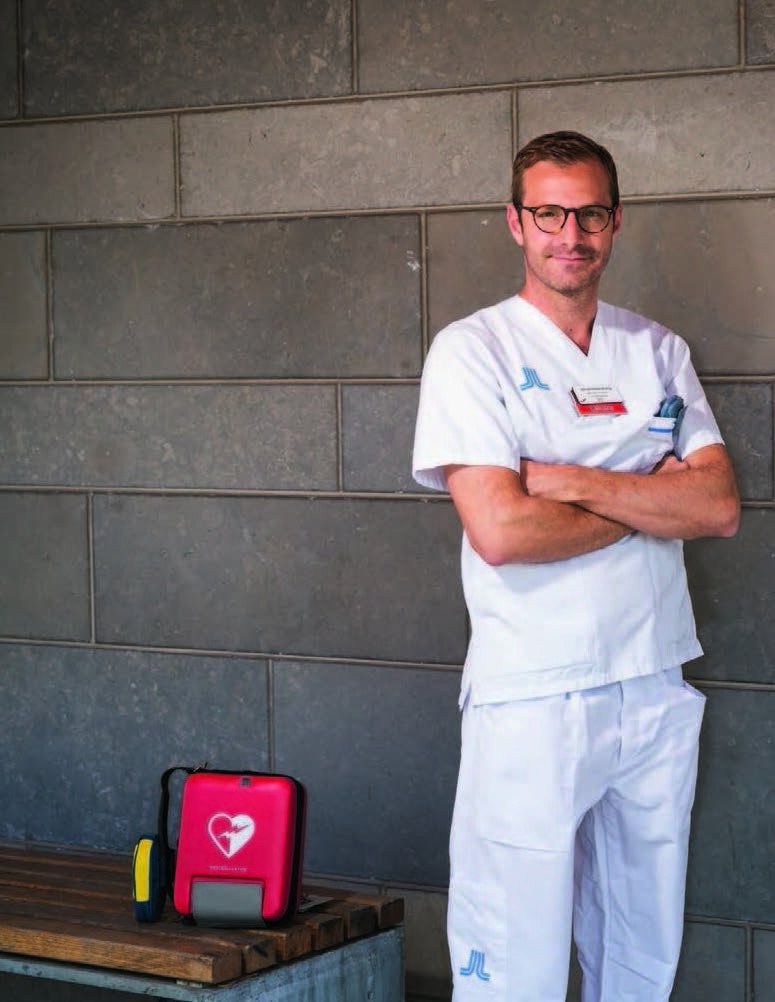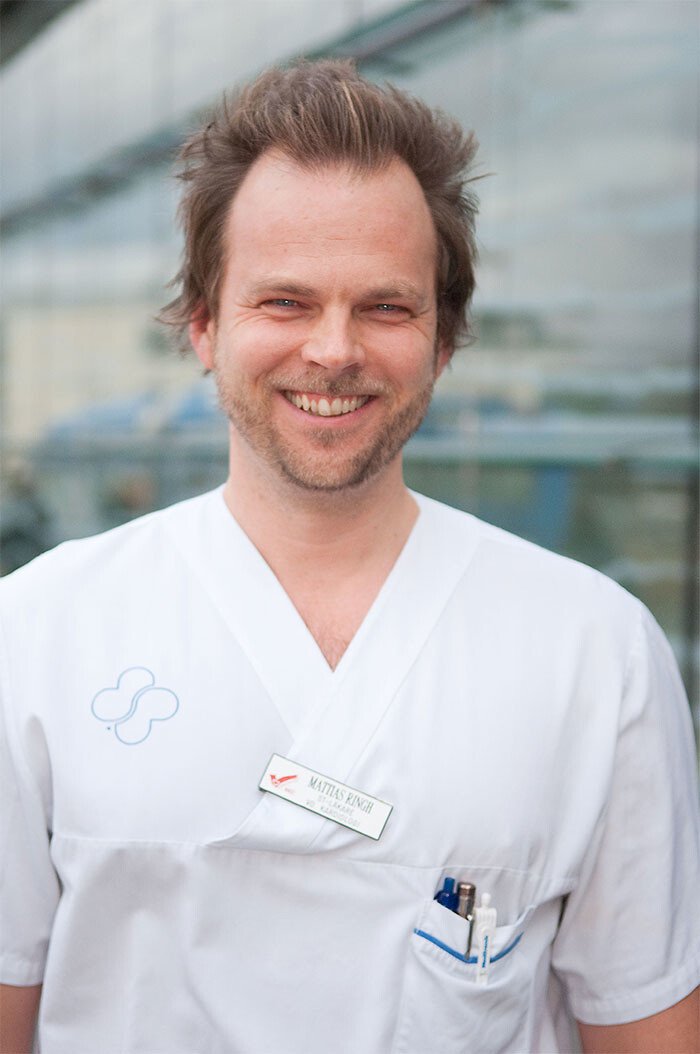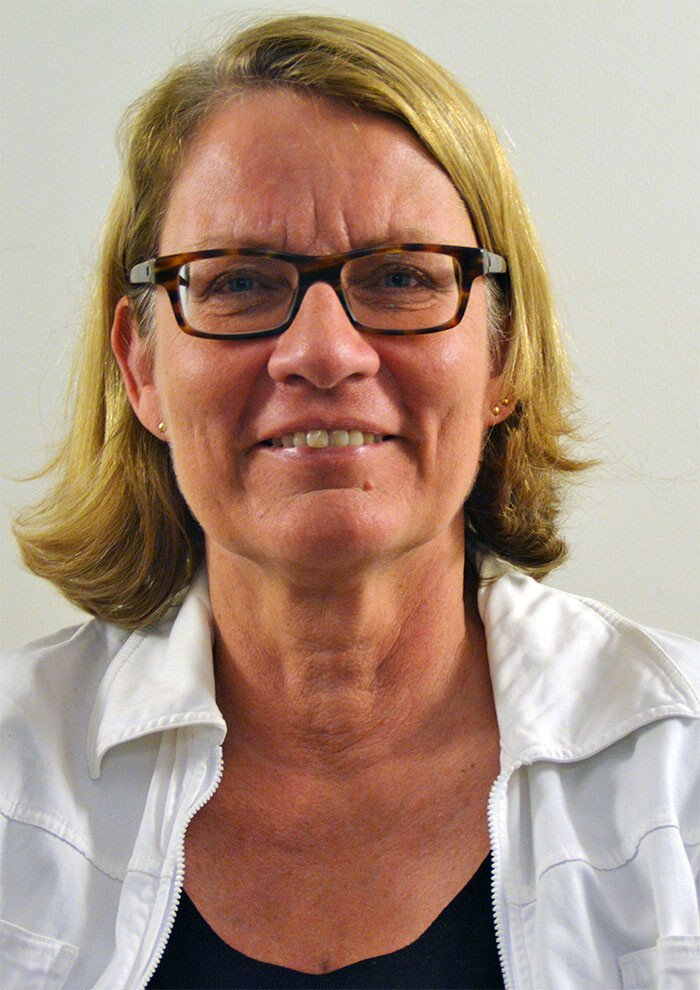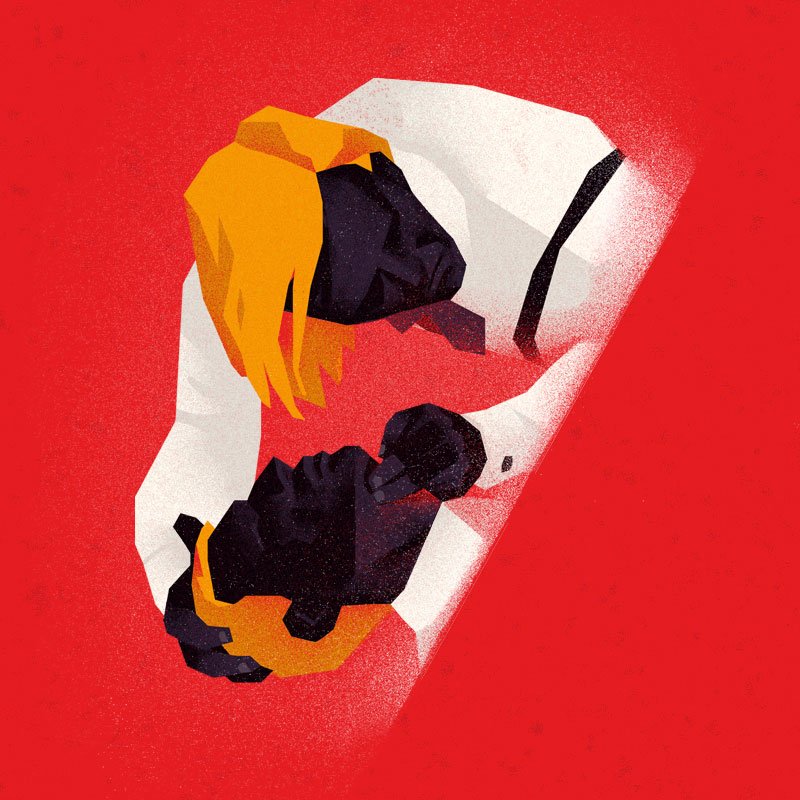Cardiac arrest – a fight against time
As few as one in ten survive a cardiac arrest outside of hospital. But researchers have a whole battery of studies underway in the attempt to optimise all parts of the chain of survival.

Text: Fredrik Hedlund, first published in the Magazine Medical Science no 1, 2016. Illustrations: Björn Öberg
A man suddenly falls over in a shopping centre. He is unconscious and has stopped breathing. The people around are looking nervously at one another – what do we have to do? Who is going to do it? I don't know, do you?
Suddenly, a woman hurries forward. She first bends over the man, then quickly and somewhat determinedly asks one of the bystanders to call the emergency services and inform them there has been a cardiac arrest. She then asks someone else to get out their phone and check whether the shopping centre has a defibrillator. “Look on hjärtstartarregistret.se”, she says and continues, “then run and get it as quickly as you can, please.”
She then immediately starts pressing hard on the middle of the man's chest with both arms. About once every 15 seconds she blows twice into the man's mouth and then continues pressing hard on his chest.
The scene abobe is fuctitious, but could give an indication of what would happen in such an event. Luckily, in this case someone turned up who was able to perform cardiopulmonary resuscitation, CPR, and knew exactly what she should do. This is far from always the case, but even if you feel uncertain about what to do, it is better to step in and do something rather than nothing.
“The worst possible thing you can do when someone suffers from cardiac arrest is to do nothing. You have to do three things as quickly as possible. Call the emergency services, begin CPR and get a defibrillator there. These are the three most important actions,” says Jacob Hollenberg, docent and specialist in cardiology at Södersjukhuset (Stockholm South General Hospital) and research leader for the Centre for Resuscitation Science at Karolinska Institutet
Cardiac arrest outside of hospital
Every year in Sweden, about 10,000 people suffer from sudden cardiac arrest outside of hospital, that means more than 25 people every day. Often this is due to a heart attack that causes a disturbance to the heart's rhythm, causing it to stop, but there are also a large number of other causes. The cardiac arrest leads to an immediate stop in blood circulation and the affected person collapses and becomes unconscious within seconds.
The most important factor in the event of a cardiac arrest is the time from it happening to CPR commencing. For each minute that passes, it is reckoned that the chances of survival decrease by ten per cent. This means that after ten minutes, the likelihood of survival is very, very small. And this is bad news.

“In Sweden, it takes an average of 11 minutes before the ambulance arrives in an emergency. And this is too long,” says Jacob Hollenberg.
Since the beginning of the 2000s, he has been researching how to increase the survival rate following cardiac arrest. At the turn of the millennium, the average survival rate in Stockholm County following cardiac arrest outside of hospital was down at three per cent, in the rest of the country it was somewhat higher; now it is between ten and eleven per cent. What has happened in the intervening period is that there has been an attempt to optimise all parts of what is known as the chain of survival.
“This involves raising the alarm quickly, early defibrillation, early advanced CPR and improved intensive care. All parts of the chain are important, but is mainly the initial parts that have improved over time. This is the time until CPR and the time to defibrillation and primarily that the proportion of patients who receive this treatment has increase,” he says.
“Of course it is good that survival following cardiac arrest outside of hospital has increased so much in the last 15 years, but it is not good enough”, argues Jacob Hollenberg. In cities such as Stavanger in Norway, Amsterdam in the Netherlands and Seattle in the United States, doctors, the emergency services and the general public have demonstrated that it is possible to increase the survival rate following cardiac arrest outside of hospital to between 20 and 25 per cent. This is want he wants to achieve in Sweden as well.
“In these countries, there has been a major focus on these issues. This has resulted in a high proportion of people receiving CPR and response times being quite short. These are the two most important components, he says.
A whole range of questions
In order to improve the chances of survival in Sweden, he and his colleagues at the Centre for Resuscitation Science are currently involved in investigating a whole range of questions and ideas, both out in the community and in hospitals. They have achieved most with the community projects. They began by investigating the extent to which CPR before the ambulance arrives is actually beneficial. Although this seems obvious, the basic conditions must be identified before devoting resources to changing something.
“CPR has certainly been thought to be important in the past, but there are no randomised studies in this area. What we did was to conduct a major study of three decades of cardiac arrests in Sweden in which we analysed the patients who received CPR prior to the ambulance arriving and those who did not. We were able to see that those who had received CPR before the ambulance arrived were more than twice as likely to survive. That is an awful lot”, says Jacob Hollenberg.
The study encompassed over 30,000 cases of cardiac arrest between 1991 and 2011 and about half of those affected received CPR prior to the ambulance arriving. Accordingly, these people had more than twice the chance of surviving, compared with those who did not receive it. In spite of this, only one in ten survived. Of those who did not receive CPR before the ambulance arrived, only one in 25 survived. The study was published in 2015 in the New England Journal of Medicine, one of the world's foremost medical journals.
“We were able to see that CPR benefitted survival, regardless of who was affected. It didn't matter whether it was a man or a woman, a young person or an old person, whether the person was at home or outdoors, what caused the cardiac arrest, or when it happened. Consequently, it was the case that CPR administered prior to the ambulance arriving could be linked to an increased survival rate,” says Jacob Hollenberg.
As such, one main concern is to ensure that the proportion of persons who receive CPR before the ambulance arrives increases. The study also shows a clear link between the number of persons who underwent CPR training in the community during the 30 years that were reviewed, and the number of persons who receive CPR from volunteers. Therefore, Jacob Hollenberg argues it would be good if everyone in Sweden knew how to perform CPR, and he has been working to achieve this.
“Yes, and we have now actually succeeded in making this a compulsory element in schools. The National Agency for Education has decided that all pupils in lower-secondary school are to undergo training in CPR and first aid,” he says. One further logical occasion for CPR training could be while learning to drive, which is already the case in Denmark, for example, but it has yet to be successfully introduced in Sweden.
Get people who know CPR
The researchers have instead considered how to get people who know CPR to a cardiac arrest faster. The answer became the project SMS-lifesavers. This involves volunteers, who have undergone CPR training, registering themselves via an app that can be downloaded for free from App Store and Google Play. In the event of a suspected cardiac arrest, SOS Alarm sends a text message to everyone who has registered and who is within a 500 metres radius of the suspected cardiac arrest, something which is possible thanks to the GPS function in mobile phones. The system has been investigated in a study, which was also published in the New England Journal of Medicine in 2015, and which looks at the effects of SMS-lifesavers in Stockholm between April 2012 and December 2013.
In this, Mattias Ringh, specialist doctor from the cardiology clinic at Södersjukhuset and researcher at the Centre for Resuscitation Science, is able to demonstrate that those who suffered from cardiac arrest where the SMS-lifesavers system was in use received CPR from volunteers in 62 per cent of cases, whereas those where the system was not activated only received it in 48 per cent of cases. Thus, there is a clear increase thanks to the system. So far, the system is only in place in Stockholm, but it is in the process of spreading.
Facts: The difference between heart attack and cardiac arrest
In the event of a sudden cardiac arrest, the heart stops pumping blood because the electrical wiring to the heart does not work as it should. The brain is affected by the lack of oxygen and the person affected becomes unconscious in only a few seconds.
A heart attack is a circulatory disturbance that is caused by a plug or blockage in one of the heart's coronary arteries, resulting in the heart being affected by lack of oxygen. The heart carries on beating, but the part of the heart that doesn't receive oxygen is injured. Heart attacks mainly result in sudden chest pain, but can also have more diffuse symptoms, especially among women. A heart attack can cause a cardiac arrest.

“I know that Region Västra Götaland will begin using it in 2016. Then, there are a lot of county councils that have enquired about it and are interested and wonder when we are coming to their area. But we are, as you know, a research group so we are only pursuing this for research purposes,” says Mattias Ringh.
Instead, it is up to each county council to make a decision themselves regarding whether to introduce the system. The qualifications for becoming an SMS-lifesaver in Stockholm are that you have at some point undergone CPR training.
“We have deliberately chosen not to have a high threshold. It is easy to make this too difficult. We don't want to put up walls that deter people from intervening; at the same time, we would prefer people who know what they are doing. That is why we also offer free refresher courses, says Mattias Ringh.
Only a week or so before the interview, an SMS-lifesaver gained media attention as they had left a dinner suddenly to assist with a cardiac arrest in the neighbourhood. Immediately, there was a flood of volunteers interested in registering as SMS-lifesavers.
“What has struck me specifically about this project is people's desire to step in and make a contribution,” says Jacob Hollenberg.
“If a defibrillator is used before the ambulance arrives, the likelihood of survival increases five fold. We have looked at data from Stockholm County and have seen that in cases where a defibrillator is used in a public place, seven out of ten survive,” says Mattias Ringh.
Public defibrillators
Over the course of the 2000s the number of public defibrillators has greatly increased. There are now an estimated 40,000 defibrillators in offices, swimming pools, sports facilities, shopping centres and other places all around Sweden. However, if you feel a little unsure about approaching a stranger and pushing down on their chest with your hands, your insecurity will most probably increase dramatically when you are instead expected to give that person an electric shock. But that is not necessary, according to Mattias Ringh.
“No, modern defibrillators are self-explanatory, they tell you what to do and you can't go wrong. The defibrillator reads the patient's ECG and if the patient has a normal heart rhythm, for instance when someone has fainted, it will not administer a shock. However, if the patient has a ventricular fibrillation, the apparatus detects this and recommends an electric shock. There are several cases from around the world in which children, teenagers, have used a defibrillator successfully,” he says.
No training is actually required at all. The Swedish Resuscitation Council do recommend that you attend a course, but this is mainly to ensure that you become familiar with them.
“People who have undergone training are more inclined to use defibrillators and they do so more quickly”, says Jacob Hollenberg.
A more serious problem is actually finding a defibrillator. In spite of there being quite a lot of them, few people know where they are in the event of an emergency. Jacob Hollenberg talks about how, while he was studying for his PhD, there were several cases of cardiac arrest in central Stockholm where there were defibrillators nearby, but no one knew they were there so they were never used. In his role as chair of the Swedish Council for Resuscitation's working groups, he therefore took the initiative to set up the national defibrillator register. This is where owners of defibrillators can register their devices, which, following a validation process, then appear on a map. The map is smart in that it only shows those defibrillators that are available at the time in question. If a defibrillator is kept at an office that closes at 6 pm and an alarm is raised at 8 pm, it will not be shown.
“We do not want to send people to places where they cannot access a defibrillator,” says Jacob Hollenberg.
The defibrillator register is also linked to the SMS-lifesavers app so that when the alarm is raised about a suspected cardiac arrest, the nearest defibrillator is also shown. But there are still many defibrillators that are not in the register. Jacob Hollenberg estimates that only one third of defibrillators are included. While suppliers are encouraged to report the sale of any new defibrillators, the system is voluntary, so the registration is entirely up to the defibrillators' owners.
Another matter which is being investigated by Jacob Hollenberg and his research group is whether it is necessary to blow into the mouths of those who have suffered a cardiac arrest when conducting CPR, or if it is sufficient to just perform compressions.
“The theory behind the claim that compressions may be sufficient is that when someone suffers a cardiac arrest, their blood is well saturated with oxygen. Furthermore, a small volume of air is pushed into and out of the chest during the compressions. In addition, when giving breaths it is not possible to compress the chest, and new data shows that interrupting chest compressions is very harmful. When the heart stands still, CPR must, in principle, be performed continuously, says Jacob Hollenberg.
Therefore, he initiated the study TANGO 2 just over one year ago which involves emergency operators randomly instructing the general public to either give breaths or not when persons call in to raise the alarm about a cardiac arrest. The patients are then followed up.
Tested with ambulance personnel
At the befinning of December 2015, an American study was published in which performing breaths or not had been tested with ambulance personnel in close to 24,000 cardiac arrests. The study showed that there was no significant difference in the total survival rate or the rate of survival with good neurological function, but that survival is slightly shortened following admission for those patients who had not received breaths.
“The study was neutral, in other words, there was no significant difference between the methods. However, it should be remembered that the study was conducted in the ambulance, which in Sweden would equate to at least ten minutes following a cardiac arrest. It will not be possible to recommend only providing compressions in the ambulance on the basis of this study, says Jacob Hollenberg.
When the study, which is run from the Centre for Resuscitation Science, is complete, it will hopefully provide clear confirmation about what the general public should do. However, until such time, the recommendation that people who have undergone CPR training provide 30 compressions followed by two breaths applies. People who are not trained or do not want to perform breaths may only perform compressions.
As time is such a critical factor in the event of a cardiac arrest, it is also problematic that ambulances in Sweden have an average response time of eleven minutes. The researchers at the Centre for Resuscitation Science are also trying to come up with new ideas relating to this.
“We have around 70 emergency in the whole of Stockholm County. They provide two million inhabitants with everything. But the fire and rescue service has around 100 vehicles with defibrillators. If we call on them, this doubles the resources at our disposal,” says Jacob Hollenberg.
An initial project involved both the ambulance and fire service in the whole of Stockholm County being dispatched to patient with suspected cardiac arrest between 2006 and 2009. The county was divided into four different types of area, depending on the population density. The results indicated that the response times decreased in all areas compared with previously, with the greatest improvement in rural areas, where the average response time decreased from 13 to ten minutes, and the least difference being in the inner city, where it went from 5.8 to five minutes. But an unexpected finding was that the survival rate increased in the inner city and suburbs, but not in rural areas.

“We interpret these results as indicating that it is the first seven/eight minutes that are extremely important. It is in this period that important interventions using CPR can be made in order to increase the survival rate in cases of cardiac arrest. Reducing the time from 13 to ten minutes does not have the same impact on survival. This is because after 10 minutes without CPR, the chances of survival are very remote,” says Ingela Hasselqvist-Ax, anaesthetic nurse and PhD student at the Centre for Resuscitation Science.
She is one of the researchers behind this study and she talks about how data is currently being analysed from a major interventional study in nine counties in Sweden, which involves all three emergency services, ambulance, fire service and also the police, responding to cardiac arrests outside of hospitals. For example, the police in Stockholm County have about 140 defibrillators in their vehicles.
Enables a faster response
“They are out there, driving around the city in vans and police cars, they move around in the community in a completely different way to the other emergency services. So if we can put in place an emergency response system that enables a faster response, we believe we can further increase the survival rate with the help of the police,” she says.
Another way to deal with the tight time-frame is to try to buy some time as soon as the patient is reached. This can be done through cooling; an ongoing study uses a type of nose prong is to spray a coolant into the patient's nose on site when the ambulance arrives. The technique has been used in a previous study that was unfortunately too small to demonstrate any clear effects. The new study, which is significantly larger and led from Karolinska Institutet, encompasses more than 10 centres in Europe and will hopefully show that it is possible to save more people by cooling the patient at an early stage.
Another way to improve the odds of survival is actually in the hands of the patients themselves. A new American study shows that every other person who suffers a sudden cardiac arrest experiences different warning symptoms such as chest pains, breathlessness, palpitations, fainting, stomach ache, feeling unwell, vomiting or back pain up to four weeks prior to the cardiac arrest. But only two of every ten of these make contact with health services. If more of them did so, more could probably be saved. But at the same time, many of these symptoms are rather vague and relatively common so Jacob Hollenberg does not want to issue any general recommendation that advices everyone with the slightest episode of breathlessness is to call in an emergency.
“It's about having a nuanced picture of this. If you have severe chest pain or breathlessness, then you should call 112, but if you are a little dizzy and experience chest pain during an extremely short period of time, there is no danger,” he says.
When cardiac arrest patients arrive in hospital, there are also a number of questions concerning the best way to take care of them. One of these concerns who is to undergo coronary angiography with potential angioplasty.
This is a relevant issue as the majority of cardiac arrests outside of hospital are due to an underlying heart attacks that, in turn, is often caused by coronary artery disease, i.e. a constriction or blockage of one or more arteries around the heart. Currently, hospitals follow the same recommendations that apply to heart attack patients, i.e. that those who have a specific pattern on their ECG undergo angiography. However, it is unclear whether the same guidelines should apply to cardiac arrest patients, says Jacob Hollenberg.
“It is a major clinical question that we are investigating in a study called DISCO, which is a nationwide project that we are conducting together with researchers in Uppsala and Lund and at Karolinska University Hospital and Södersjukhuset. In this, we are investigating for which cardiac arrest patients angiography is life saving. However, we do not have any results yet,” he says.
Placing them on a heart-lung machine
Another question is whether it could be possible to save some patients by placing them on a heart-lung machine as soon as they arrive in hospital, known as ECMO. Jacob Hollenberg is right now planning a study that will investigate this.
“Firstly, it will involve young, well-selected patients suffering from a certain type of cardiac arrest that does not respond to the usual treatment,” he says.
In the event of a cardiac arrest that takes place outside of hospital, the major challenge is getting the patients to a hospital fast enough. But cardiac arrest also happen in hospital. And even if it is the same physical condition, the questions concerning treatment are completely different. In order to increase the survival rate as much as possible, Jacob Hollenberg is trying to ensure that the care process runs smoothly, from suffering a cardiac arrest to receiving intensive care. However, the problem is pretty much the opposite in hospital. The care process in hospitals already runs smoothly.

“We know a lot more about patients who suffer from cardiac arrests in hospital, the crash team is there within three or four minutes and we have a huge amount of resources that we are able to put in place. In principle, we could keep everyone alive as long as we want, so the question for us is; Who are we going to do what to?” says Therese Djärv, doctor in charge of CPR at Karolinska University Hospital, specialist in internal medicine and acute care and docent at the Centre for Resuscitation Science at Karolinska Institutet.
It becomes an ethical question that centres around when an intervention is beneficial to the patient and when it is not. And we still know little about this. Therese Djärv is therefore studying how the combination of acute and chronic diseases affects survival in the event of a cardiac arrest in hospital. She has just finished a study of the impact of chronic diseases and has come up with a type of scale that shows the chance of survival in the event of various diseases.
“The next stage involves us linking this to the acute diseases and seeing what emerges. When we have done this, we can connect this to the ethics,” she says. But there will never be a schedule that says who will be resuscitated in the event of a cardiac arrest and who will not.
“That also has an awful lot to do with the patient's own attitude. The patient's perspective has to be the starting point. Consequently, patients should be prepared to discuss ethical issues with their doctor if they have severe chronic diseases with an expected course,” she says.
Many readers are perhaps thinking that it is natural that people want to be saved in the event of a cardiac arrest, but many doctors actually argue that a sudden cardiac arrest is probably the best of all ways to die if you have lived a long life. The alternatives are, unfortunately, often some form of cancer or dementia, which to many people appear as less attractive.
Easier to discuss
However, Therese Djärv thinks that in Sweden, we are not good enough at having these conversations. It is not something that takes place routinely, as is the case in the United States, for example, and therefore patients become a little frightened when the topic is brought up. But it may become easier to discuss thanks to the new information about the chances of survival that will emerge from her research.
A completely different aspect of her research involves investigating drugs used in the event of cardiac arrest. There are not that many, but the one that is most commonly used by both paramedics and hospital staff is adrenalin. However, its effect in the event of cardiac arrest is not particularly well understood.
“This is about clinical practice and experience, people believe in a mechanism and so they go with it,” says Therese Djärv.
She is therefore planning, along with researchers in Västra Götaland, to carry out a study in order to investigate the effects of adrenalin in the event of cardiac arrest in hospital.
She is also thinking about investigating whether a drug that is now mainly used in heart failure, levosimendan, can improve the outcome for patients with cardiac arrest. There are animal studies that indicate it could increase the proportion who regain a spontaneous circulation following cardiac arrest and she will be starting an animal study this year that will be followed up with a study on humans if the results are promising.
“So this will be done a bit further ahead.”
In total, the Centre for Resuscitation Science at Karolinska Institutet has a very large number of current research projects focused on improving the situation for all those Swedish people who suffer from sudden cardiac arrest, with the aim that more will survive and be taken care of better. Jacob Hollenberg is positive about what the future will hold; he believes that Sweden can match the survival figures of the best regions in the world.
“If our most important projects confirm their hypotheses and the results are implemented in Sweden, we could really double the survival rate following cardiac arrest.
How to do CPR

Help in the event of cardiac arrest
In the event of a cardiac arrest every second counts. In case of emergency, call 112. Here are also instructions on how to do CPR (cardiopulmonary resuscitation).
